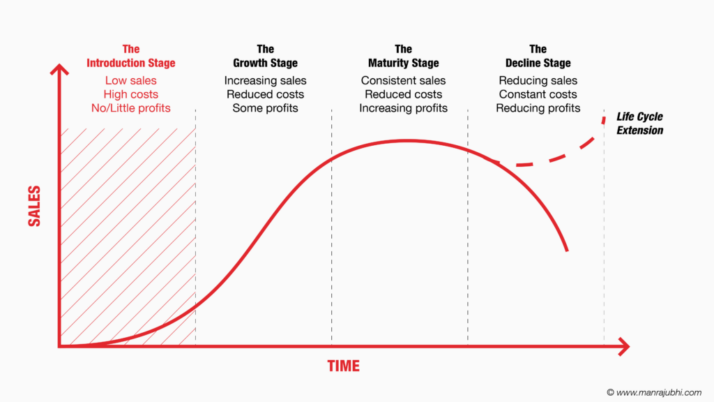Every new product follows predictable and sequential stages in its journey from conception, growth, maturity, and decline. The rise and fall in a product’s demand are known as the Product Lifecycle. Growth stage marketing signifies the period where a new product begins to succeed with higher conversion rates.
This article discusses the growth stage of the product lifecycle.
The Stages of a Product Lifecycle
Product lifecycle is the set of changes a product undergoes over time. It describes how a given product enters, grows, thrives, and declines in the marketplace. A decrease in product sales doesn’t signify its end as long as the management makes intelligent decisions.
There are four stages in the product life cycle: product introduction, growth, maturity, and decline. Knowing which of these stages your product fits into can help you make decisions that’ll help your product bounce back.
1. Introduction Stage
This is the high-stakes stage of a product where companies must establish branding and grab attention. It is the period after research and testing where the product is introduced to the market to see if customers will love it. A solid product-market strategy is implemented to build consumers’ trust at this stage. Special offers and discounts are also given to entice and attract customers.
2. Growth
Consumers have accepted the product and begun buying it at this stage. Demand and profits are growing, and competition sets in. The company also tries to expand its reach and maintain market share and relevance.
3. The Maturity Phase
The third stage is the most profitable stage, where production and marketing costs begin to decline. At this stage, interest in the product starts to stabilize. It is the Plateau, wherein the product’s value is steady, and the high-end of the market is completely saturated. New sales at this point typically come from customers replacing older products.
4. Decline stage
The final stage of the product life is its decline, where the product loses market share and relevance. At this stage, there’s a decrease in demand for the product which results in decreased sales.
Understanding that your product has entered its decline stage is the first step towards breathing new life into it. You’ll need to incorporate strategies that’ll help your product bounce back, such as improving its features and finding new uses for the product.
Growth Stage Marketing
Growth, the second stage of the product lifecycle, is the stage after the start-up or introduction of a product. It is characterized by a product’s market share increase, accelerated sales rate, and customer growth. The growth stage in a product’s evolution is when it experiences a high market demand and an exponential rise in sales.
In the growth stage, the company seeks for better ways to get its product to target audience. It also seeks to increase sales figures and make practical use of distribution channels. This stage focuses on reaching a broader audience to increase market share.
There’s also an increase in competition from other firms that create similar products. The organization thus begins to search for new ways to maintain market relevance. Improvements may be made on product packaging and manufacturing. The company will naturally focus its resources and efforts on the fulfillment of mass market needs. It’s during this stage that companies take a look at their supply chains and come up with new, more efficient production techniques.

Conclusion
Growth stage marketing is when there’s a recurrent increase in market share, customer base, and accelerated sales. At this point in marketing, several people better recognize and accept the brand.
This stage is not without its challenges – it is the time when new competitors tend to appear in the market. At this stage, the business seeks for innovative ways to reach its target audience and maintain market relevance.
Explore All Growth Marketing Articles
SEO Growth: An Interesting Guide to Improve Search Visibility
Search Engine Optimization (SEO) plays a crucial role in securing your company’s online success. As a business, you could invest…
How to Develop the Perfect Sales Growth Strategy
Entrepreneurs always aim for the best for their businesses. However, you can’t reach corporate dreams and aspirations if you just…
Product Marketing Vs Growth Marketing: Know the Difference
There are various marketing approaches to sell your brand. However, you have to make sure that the strategy you’re using…
Growth Product Manager: Overview & Responsibilities
The growth process is a hybrid of activities, including discovery, experimentation, forecasting, and testing. Product Growth Managers make decisions about…
8 Growth Plan Examples for Your Business
When it comes to business growth, companies have plenty of opportunities to invest. But because there are so many options…
Top Seven Growth Marketing Channels
An important part of any marketing strategy is understanding what marketing channels work the best for a specific company. Data…
